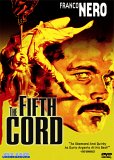| Reviews & Columns |
|
Reviews DVD TV on DVD Blu-ray 4K UHD International DVDs In Theaters Reviews by Studio Video Games Features Collector Series DVDs Easter Egg Database Interviews DVD Talk Radio Feature Articles Columns Anime Talk DVD Savant Horror DVDs The M.O.D. Squad Art House HD Talk Silent DVD
|
DVD Talk Forum |
|
|
| Resources |
|
DVD Price Search Customer Service #'s RCE Info Links |
|
Columns
|
|
|
Fifth Cord, The
Franco Nero stars as Andrea Bild, a stereotypical newspaper reporter, a self-loathing alcoholic with "crazy nonconformist ideas" and separated from a former lover (Silvia Monti). Following a New Year's party Andrea confronts her, while elsewhere Australian John Lubbock (Maurizio Bonuglia) is attacked by an unknown assailant and found by a young couple making out under a bridge, the woman (Agostina Belli) being the sister of Lu Auer (gorgeous Pamela Tiffin), Andrea's present girlfriend. Lubbock is apparently in love with Isabel (Ira von Furstenberg) but she's dating Edouard Vermont (Edmund Purdom), and they become suspects in Lubbock's attack.
Soon after, Sophia (Rossella Falk), the crippled wife Dr. Richard Bini (Renato Romano), is brutally murdered, and it eventually it becomes clear (well, sort of) that various socialites who attended the party all knew one another, and that they are being murdered off one-by-one. As Andrea looks further the case, he himself becomes a suspect in the local inspector's (Wolfgang Preiss) investigation.
The Fifth Cord starts out well but soon overwhelmed with false leads and red herrings, so much so that it becomes impenetrable by the end. It's one of those films where about halfway through you give up trying to follow the story's machinations, sit back and get what there is to get out of the experience watching the major set pieces, performances and production polish.
In this sense The Fifth Cord is quite successful. Cinematographer Vittorio Storaro, later the celebrated DP of such films as Apocalypse Now (1979), Reds (1981), and The Last Emperor (1987) - winning Academy Awards for all three - gives this very ordinary movie an extraordinary look that exhibits the same level of thought and imagination as, for example, John Alcott and Stanley Kubrick's work on that same year's A Clockwork Orange. (Besides contrasting the flesh-and-blood characters with austere modern architecture, both films favor symmetrical compositions.)
Working with the film's largely forgotten director, Luigi Bazzoni, Storaro obviously sought out architecturally interesting locations for both exteriors and interiors where he could shoot the film's characters against modernistic geometrical patterns and shapes. The locations are fascinating all by themselves (featuring some knockout apartments, homes, and offices), perhaps further inspiring Storaro.
His work also adds enormously to the film's major set pieces, the various murders, which are admirably intense. (Particularly good is a genuinely harrowing sequence with a little boy alone in a house with the killer.) He proves himself a great lighting cameraman with subtle work throughout (with especially good shots of silhouetted characters), and though his use of fish-eye lenses and subjective camera angles showing the killer's point-of-view has since become a cliche back in 1971 is was pretty innovative.
The film also benefits from a good if not quite great score by Ennio Morricone, while Franco Nero, Pamela Tiffin (an American expatriate memorable a decade earlier as the boss' daughter in Billy Wilder's One, Two, Three) deliver fine performances that again rise above the material.
Video & Audio
The Fifth Cord is presented in a fine 16:9 widescreen transfer at 1.77:1 that's impressively sharp with good color (original lab: Technochrome) throughout. The audio is English mono only with no Italian track or subtitles, though this is not really a problem as the cast is obviously speaking English on-camera anyway and Nero loops his own voice. English title elements are used.
Extra Features
Supplements include the usual international Theatrical Trailer in 16:9 format and, also 16:9, a typically entertaining and informative Blue Underground featurette: Giornata Nera (Black Days): Interviews with Star Franco Nero and Cinematographer Vittorio Storaro. The 16-minute show gets to the heart of the film's basic appeal ("Mama mia!" Nero exclaims, talking about the Storaro's camerawork) while admitting each was eager to move onto bigger and better things. (The latter had just finished Bertolucci's The Conformist, while Nero shot scenes for Pope Joan on his days off.)
Parting Thoughts
You'll need a scorecard to keep track of the story, but for its visuals alone The Fifth Cord will appeal to giallo fans.
Stuart Galbraith IV is a Kyoto-based film historian whose work includes The Emperor and the Wolf - The Lives and Films of Akira Kurosawa and Toshiro Mifune and Taschen's forthcoming Cinema Nippon. Visit Stuart's Cine Blogarama here.
|
| Popular Reviews |
| Sponsored Links |
|
|
| Sponsored Links |
|
|
| Release List | Reviews | Shop | Newsletter | Forum | DVD Giveaways | Blu-Ray | Advertise |
|
Copyright 2024 DVDTalk.com All Rights Reserved. Legal Info, Privacy Policy, Terms of Use,
Manage Preferences,
Your Privacy Choices | |||||||














